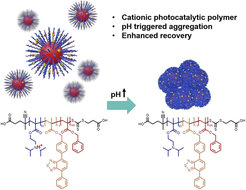pH-Triggered Recovery of Organic Polymer Photocatalytic Particles for the Production of High Value Compounds and Enhanced Recyclability
Photocatalytic nanoparticles are presented that are active and well-dispersed under acidic conditions but aggregate instantly upon elevation of pH. These responsive photocatalytic polymers can be used in various photocatalytic transformations, including CrVI reduction and photoredox alkylation of an indole derivative. The particles could be readily recycled, allowing multiple successive photocatalytic reactions with no clear loss in activity.

Pseudo-homogeneous polymeric photocatalysts are an emerging class of highly efficient and tunable photocatalytic materials, where the photocatalytic centers are easily accessible. The creation of highly efficient photocatalytic materials that can be rapidly separated and recovered is one of the critical challenges in photocatalytic chemistry. Here, we describe pH-responsive photocatalytic nanoparticles that are active and well-dispersed under acidic conditions but aggregate instantly upon elevation of pH, enabling easy recovery. These responsive photocatalytic polymers can be used in various photocatalytic transformations, including CrVI reduction and photoredox alkylation of indole derivative. Notably, the cationic nature of the photocatalyst accelerates reaction rate of an anionic substrate compared to uncharged species. These photocatalytic particles could be readily recycled allowing multiple successive photocatalytic reactions with no clear loss in activity.












